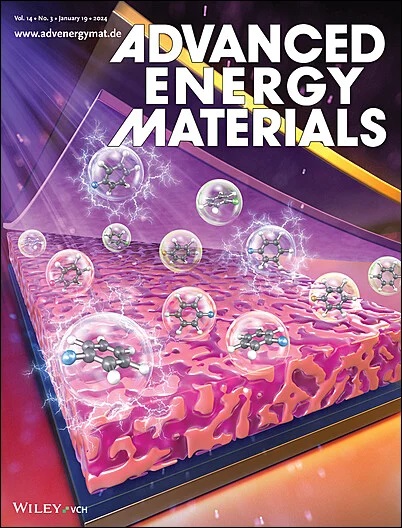Facile Microwave Synthesis of Kilogram-Scale Electrocatalysts with Nanocarbons Bridged Cobalt Active Sites for Enhanced Oxygen Electrocatalysis
IF 24.4
1区 材料科学
Q1 CHEMISTRY, PHYSICAL
引用次数: 0
Abstract
Oxygen reductions and evolution reactions (ORR/OER) are pivotal electrochemical processes in fuel cells and metal-air batteries, yet the rapid, large-scale production of efficient ORR/OER electrocatalysts remains challenging. Herein, a groundbreaking microwave-synthesis strategy is presented that enables the rapid and facile preparation of kilogram-scale ORR/OER electrocatalysts. The unique microwave irradiation generates instantaneous thermal energy, facilitating the formation of nano-carbon bridges that interconnect high-density active sites comprising cobalt single atoms and nanoparticles. This innovative architectural configuration significantly enhances the kinetics of electron/mass transfer and maximizing the accessibility of active sites. The optimized carbon-bridged cobalt catalyst (CBCo-800) demonstrates a commendable half-wave potential (E 1/2) of 0.86 V versus RHE and a minimal overpotential difference (ΔE) of 0.696 V. Furthermore, lab-assembled zinc-air battery utilizing CBCo-800 achieved a great specific capacity of 794 mAh g−1 and sustained over 650 h, outperforming commercial Pt/C and RuO2 catalysts. Density functional theory (DFT) calculations elucidate that the nanocarbon bridge between the dual-active sites boosts oxygen activation and optimizes the adsorption/desorption dynamics of *OH/*OOH intermediates, thereby lowering the energy barriers for ORR/OER. This study offers a facile solution for producing dual-active site materials, and also establishes a robust platform for the mass production of high-performance electrocatalysts.

微波合成千克级纳米碳桥接钴活性位点电催化剂的研究
氧还原和进化反应(ORR/OER)是燃料电池和金属-空气电池中关键的电化学过程,但快速、大规模生产高效的ORR/OER电催化剂仍然具有挑战性。本文提出了一种突破性的微波合成策略,可以快速简便地制备公斤级ORR/OER电催化剂。独特的微波辐射产生瞬时热能,促进纳米碳桥的形成,连接由钴单原子和纳米颗粒组成的高密度活性位点。这种创新的结构配置显著提高了电子/质量传递动力学,并最大限度地提高了活性位点的可及性。优化后的碳桥钴催化剂(CBCo-800)与RHE相比,半波电位(E1/2)为0.86 V,过电位差(ΔE)最小,为0.696 V。此外,使用CBCo-800的实验室组装锌空气电池的比容量达到794 mAh g - 1,持续时间超过650小时,优于商用Pt/C和RuO2催化剂。密度泛函理论(DFT)计算表明,双活性位点之间的纳米碳桥促进了氧的活化,优化了*OH/*OOH中间体的吸附/解吸动力学,从而降低了ORR/OER的能垒。本研究为生产双活性位点材料提供了一个简单的解决方案,也为大规模生产高性能电催化剂建立了一个强大的平台。
本文章由计算机程序翻译,如有差异,请以英文原文为准。
求助全文
约1分钟内获得全文
求助全文
来源期刊

Advanced Energy Materials
CHEMISTRY, PHYSICAL-ENERGY & FUELS
CiteScore
41.90
自引率
4.00%
发文量
889
审稿时长
1.4 months
期刊介绍:
Established in 2011, Advanced Energy Materials is an international, interdisciplinary, English-language journal that focuses on materials used in energy harvesting, conversion, and storage. It is regarded as a top-quality journal alongside Advanced Materials, Advanced Functional Materials, and Small.
With a 2022 Impact Factor of 27.8, Advanced Energy Materials is considered a prime source for the best energy-related research. The journal covers a wide range of topics in energy-related research, including organic and inorganic photovoltaics, batteries and supercapacitors, fuel cells, hydrogen generation and storage, thermoelectrics, water splitting and photocatalysis, solar fuels and thermosolar power, magnetocalorics, and piezoelectronics.
The readership of Advanced Energy Materials includes materials scientists, chemists, physicists, and engineers in both academia and industry. The journal is indexed in various databases and collections, such as Advanced Technologies & Aerospace Database, FIZ Karlsruhe, INSPEC (IET), Science Citation Index Expanded, Technology Collection, and Web of Science, among others.
 求助内容:
求助内容: 应助结果提醒方式:
应助结果提醒方式:


